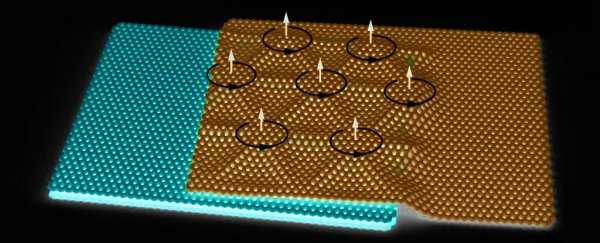For something that largely exists in just two dimensions, graphene seems to be everywhere. The super-thin 'wonder material' is famous not only for its incredible strength, but also its unique, often surprising mix of thermal and electromagnetic properties.
In recent times, many of the strangest experimental discoveries in graphene research have been made when scientists stack separate layers of graphene on top of one another. When ordinary materials combine like this, nothing much happens, but even layering a few sheets of graphene together seems to produce unusual and unexpected electronic states.
Now, a new study led by researchers at Columbia University and the University of Washington has found another incidence of this kind of behaviour when graphene's one-atom-thick lattices come into contact with each other.
"We wondered what would happen if we combined graphene monolayers and bilayers into a twisted three-layer system," says Columbia University physicist Cory Dean.
"We found that varying the number of graphene layers endows these composite materials with some exciting new properties that had not been seen before."
In recent years while investigating the effects of graphene layering, scientists discovered that twisting one of the layers ever so slightly – so that the two sheets are resting at a slightly offset angle – produces what's known as a twisted 'magic angle' structure, which can alternate between being an insulator and a superconductor (either blocking electricity flowing through the material, or facilitating it with no resistance).
In the new work, Dean and his team experimented with a three-layer graphene system, constructed from a single monolayer sheet stacked on top of a bilayer sheet, and then twisted by about 1 degree.
When subjected to extremely cold temperatures, just a few degrees warmer than absolute zero, the twisted monolayer–bilayer graphene (tMBG) system, demonstrated an array of insulating states, which could be controlled by an electric field that was applied to the structure.
Depending on the direction of the applied electric field, the tMBG's insulation capacity altered, resembling that of twisted bilayer graphene when the field was pointed towards the monolayer sheet.
When the field was reversed, though, pointing towards the bilayer sheet, the insulating state resembled that of a four-layer graphene structure composed of a twisted double bilayer system.
That's not all the team found, however. During the experiments, the team detected a rare form of magnetism only recently discovered.
"We observe the emergence of electrically tunable ferromagnetism at one-quarter filling of the conduction band, and an associated anomalous Hall effect," the researchers write in their paper.
The Hall effect traditionally refers to when voltage can be deflected by the presence of a magnetic field, and a related phenomenon called the quantum Hall effect – seen in two-dimensional electron systems like graphene – produces an anomaly where amplifications of the effect jump up in quantised steps, not in a straight, linear increase.
Recent research has uncovered this magnetic behaviour in graphene systems incorporating crystals of boron nitride.
Here, for the first time, though, physicists have created the same anomaly, only this time, they've somehow done it with graphene all by itself, which is quite something given the atoms we're dealing with.
"Pure carbon is not magnetic," says Yankowitz. "Remarkably, we can engineer this property by arranging our three graphene sheets at just the right twist angles."
The findings are reported in Nature Physics.
